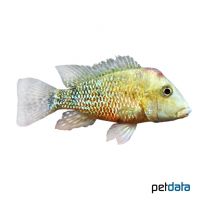Redhump Eartheater (Geophagus steindachneri)
| Redhump Eartheater Geophagus steindachneri | |
|---|---|
| Name | Redhump Eartheater |
| Name Lat. | Geophagus steindachneri |
| Family | Cichlids |
| Family lat. | Cichlidae |
| Order | Cichlids |
| Order lat. | Cichliformes |
| Origin | Colombia, Venezuela |
| Habitat | Forest streams |
| Diet | Omnivore |
| pH | 6.0-7.5 |
| Behavior | ♂ territorial |
| Keeping | Pair |
| Care Level | Difficult |
| Reproduction | Mouthbrooder |
| Breeding | Moderately difficult |
| Life Span | 8-12 years |
| Protection | No |
| Metric Units | |
| Size | 13-15 cm |
| Temperature | 20-30 °C |
| Hardness | 2-12 °dH |
| Aquarium | ~ 240 l |
| US Units | |
| Size | 5"-6" |
| Temperature | 68-86 °F |
| Hardness | 36-214 ppm |
| Aquarium | ~ 65 gal |
Distribution and habitat
Red humped cichlids are common in the Rio Magdalena watershed in Colombia. They prefer slow flowing or stagnant river sections and bays in the rainforest. Some differently colored site variants are known.
Maintenance
The aquarium should have a robust border planting, with some round river stones and roots as hiding places, and plenty of free sandy areas suitable for burrowing. A soft, deep substrate covered with some foliage (e.g. sea almond tree, oak), subdued light (floating plants) and soft, slightly acidic water with a weak current is ideal.
No ammonia, ammonium and nitrite should be detectable in the water, and the nitrate value should not exceed 100 mg/l. To ensure the water quality and oxygen content, a filter and heater adapted to the aquarium size is required, as well as lighting for the species-appropriate day-night rhythm of the animals.
Diet
The food supply consists of live, frozen and dry food. For a balanced diet, feed once daily with a high-quality sinking dry food (granules, pellets, tablets) as well as tubifex, artemia, mysis, mosquito larvae or shrimp (live or frozen). In addition, they need regular vegetable food, such as blanched leafy and wild vegetables, algae leaves or dry food with vegetable ingredients (e.g. spirulina). It is recommended to feed small portions several times a day. Only feed as much as will be eaten within a few minutes. A regular and varied diet promotes health.
Behaviour and compatibility
They should be kept in pairs or in a harem, one male with 2-3 females. Males are intraspecific incompatible. Keeping several pairs or harems is only recommended in a larger and richly structured tank. They are compatible with other fish and can be socialized well with larger South American cichlids.
Basically, only compatible fish species with similar demands on water conditions and water temperature may be socialized.
Sex dimorphism
The adult male has a strongly developed frontal hump as well as a pointed genital papilla, which is round in the female. In juveniles, the sex can hardly be determined.
Reproduction and breeding
They are ovophilous mouth brooders. The female usually spawns on a flat, well-cleaned rock or similar. After the male fertilizes the eggs, the female immediately takes them into her spacious gullet (pharynx) for mouthbrooding. After 10-14 days, the young are released from the mouth. The fry continue to be cared for by the female for some time, escaping back into the mouth in case of danger before brood care ends
Fry must be fed several times a day with special rearing food (Artemia nauplii). In community tanks breeding is hardly possible, because the fry are easy prey.
Important
They rummage through the substrate in search of food. According to this species-typical behavior, they are also called soil eaters. Plants are not eaten, but should be placed in pots and secured with stones against digging out. The foliage (sea almond tree, oak etc.) enriches the water with humic substances and lowers the pH value in a natural way.
The well-being of the fish should be checked regularly. Temperature should be checked daily, pH, hardness and nitrate levels should be checked at least every 14 days. Regular partial water changes are recommended, even if the contaminant level has not yet reached the upper limit. Sudden changes in water quality should be avoided. Newly introduced fish must be accustomed slowly to the water in the aquarium.
Further literature can be found in your pet store.
References
Text: Werner Winter; Image: petdata
Source: BMELV (1998): Tierschutzgutachten - Haltung von Zierfischen (Süßwasser); RIEHL & BAENSCH (2006): Aquarien Atlas Bd. 1, Mergus Verlag; ENGELMANN (2005): Zootierhaltung - Tiere in menschlicher Obhut: Fische, Verlag Harri Deutsch
- Gemäß § 21 Abs. 5 Tierschutzgesetz idgF
